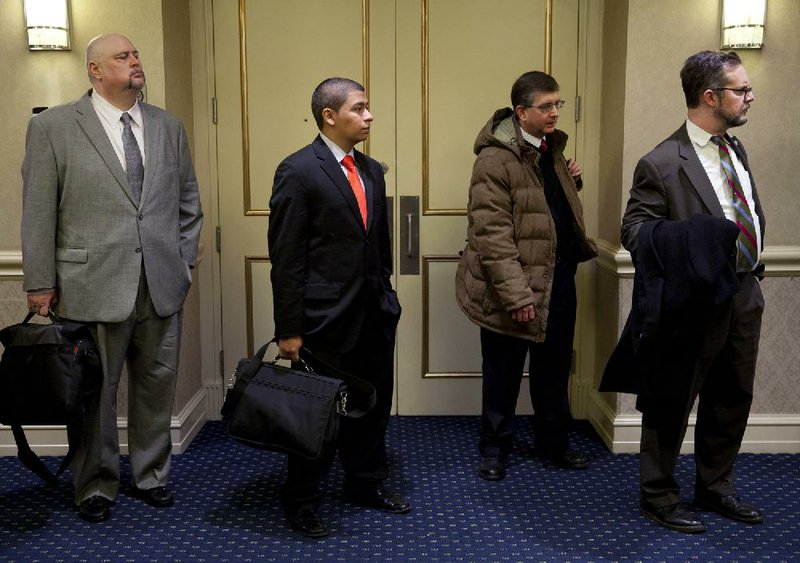WASHINGTON — The number of Americans seeking unemployment benefits jumped 20,000 last week to a seasonally adjusted 362,000, remaining at a level that suggests slow but steady improvement in the job market.
The Labor Department said Thursday that the four-week average, a less volatile measure, rose 8,000 to 360,750, the highest in six weeks. A department spokesman said heavy snowstorms in the Northeast didn’t affect the total.
Applications for unemployment benefits are a proxy for layoffs. Even with last week’s jump, they have trended downward recently. The four-week average has declined 7.5 percent since mid-November and fell to a five-year low three weeks ago.
Weekly applications “continue to show no sign of trending up,” Jim O’Sullivan, an economist at High Frequency Economics, wrote in a research note. “That is a good sign ... consistent with the recent pace in employment growth at least being maintained.”
Employers added an average of 200,000 jobs a month from November through January. That was up from about 150,000 in the previous three months.
Last week’s increase puts applications for unemployment benefits back in the 360,000-to-390,000 range, where they have fluctuated since early last year. Since then, employers have added an average of 181,000 jobs a month.
In January, the economy added 157,000 jobs. The unemployment rate ticked up to 7.9 percent from 7.8 percent in December. Economists think the rate will slowly decline if hiring continues at last year’s monthly pace of 180,000. The unemployment rate fell 0.7 percentage point in 2012.
A total of 5.6 million people received unemployment benefits in the week that ended Feb. 2, the latest period for which figures are available. That’s about 300,000 fewer than in the previous week. Some of those no longer receiving unemployment aid may now be employed. But many others have exhausted the benefits available to them.
Sales of previously owned homes rose in January to the second-highest level in three years, a sign the housing market is maintaining its recovery and helping to bolster the economy.
The National Association of Realtors said Thursday that sales rose 0.4 percent in January compared with December to a seasonally adjusted annual rate of 4.92 million. That was highest sales pace since November and the second-highest since November 2009, when a temporary home buyer tax credit had temporarily inflated sales. The median price for a home sold in January was $173,600, an increase of 12.3 percent from a year ago.
Analysts say purchases would be higher if more homes were available. The supply of homes for sale dropped to nearly an eight-year low in January.
In December, sales declined to a seasonally adjusted annual rate of 4.90 million from 4.96 million in November, according to revised figures released Thursday. The December drop was linked, in part, to the tight supply of homes.
For all of 2012, sales rose to 4.66 million, according to revised estimates. That was 9.4 percent more than in 2011 and the most since 2007. But even with the gain, sales were below the 5.5 million that economists associate with a healthy market.
Analysts foresee further improvement this year. Steady hiring and near-record-low mortgage rates have helped increase sales and prices in most markets. Still, sales are being held back by the low supply.
The cost of living in the U.S. was little changed in January for a second month as a drop in energy costs made up for gains in other goods and services, the Labor Department said Thursday in Washington.
The core measure of inflation, which excludes more volatile food and energy costs, increased by the most in more than a year, pushed up by gains in clothing, hotel rates and airline fares.
Fuel costs have climbed this month after an increase in the payroll tax also took a bite out of take-home pay, which may prompt households to rein in purchases and cause companies like Ruth’s Hospitality Group Inc. to hold the line on prices. Joblessness at 7.9 percent may also restrain wage gains, providing a further check on inflation that will give the Federal Reserve room to maintain monetary stimulus.
“The big story from the consumer standpoint is the rise in gasoline prices in the last four weeks, which will start to strain wallets at a time when there’s also a problem with tax refunds going out more slowly and the payroll tax hitting them,” said Omair Sharif, a U.S. economist at RBS Securities Inc. in Stamford, Conn.
Information for this article was contributed by Christopher S. Rugaber and Martin Crutsinger of The Associated Press and Alex Kowalski of Bloomberg News.
Business, Pages 25 on 02/22/2013

